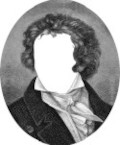
 Gerlach
Gerlach
Gustav Gerlach (~1800)

|
| The original cover for the publication "Kunst Schottische Taenze zu componiren, ohne musikalisch zu sein" (click to enlarge). |
Little is known about the German composer Gustav Gerlach. Nevertheless, it was Gerlach who, in 1830, composed a remarkable musical dice game: "Kunst Schottische Taenze zu componiren, ohne musikalisch zu sein" (Art of composing Scottish Dances, without being musical). It probably was the last example of musical dice games. Dice games were common in the classical period until the beginning of the 19th century. They were no longer common in the romantic period. This had probably to do with the fact that the fixed patterns and harmonic structures, common in the classical period, were increasingly abandoned in the romantic period. It made the music less suitable for the fixed forms of a dice game.
Gerlach's dice game is remarkable in that the execution is different from that of most dice games. Gerlach uses only one die for his game, instead of two dice. This obviously results in a much smaller number of variants, although the principle remains the same. Moreover, in the Gerlach game a roll of the die produces two bars, which then leads to a longer composition. So much for the Schottisch Tanz, as well as for the performance of the Trio, there are 8 double measures of 6 possibilities, resulting in 1,679,616 different enjoyable Tänze and an equal number of Trios.
The Editor adds in the preface to the publication: "Since all the possible musical compositions which could be composed, not only result in flowing and attractive melodies, but they also differ in their harmonious sequences and modulating structure. This makes them not only suitable for entertaining in society, but also as a help for study purposes of young composers." (Translation by the Opus Infinity team).
Sources- Haupenthal, Gerhard (1994), Geschichte der Würfelmusik in Beispiele, 2 Volumes, University of Saarbrücken.